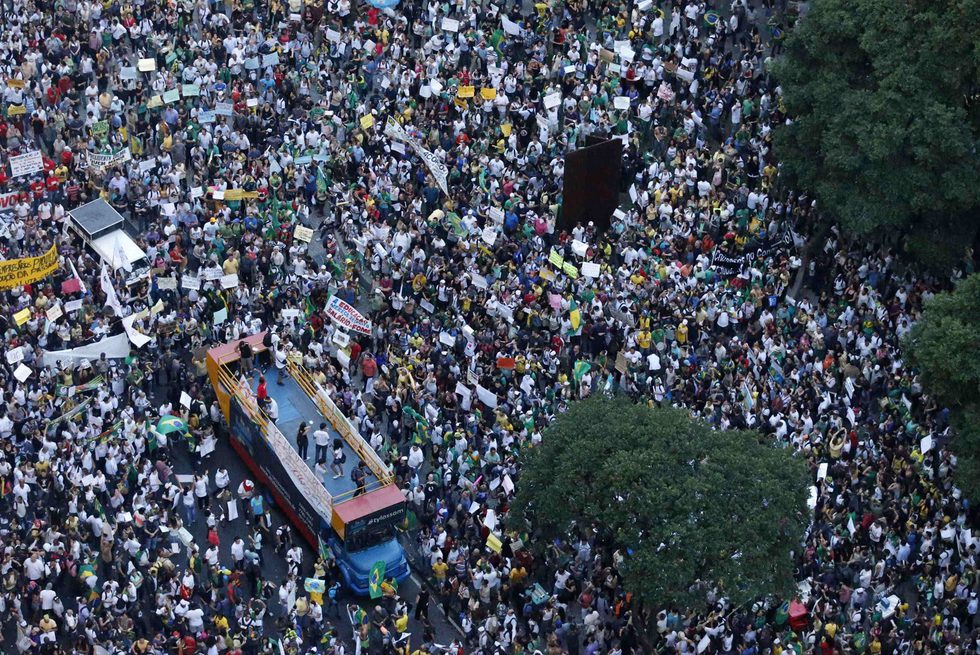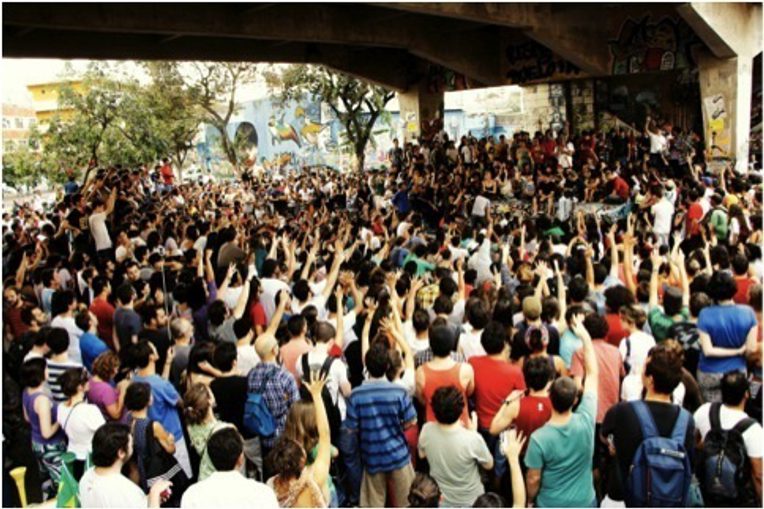On Processes and Outcomes: Remarks on the Brazilian Protests of June, 2013, and Other Experiences of “New Movements”
From the Series: Protesting Democracy in Brazil
From the Series: Protesting Democracy in Brazil

(This text is based on ideas originally presented in Portuguese in the book I co-authored, 20 centavos: A luta contra o aumento [São Paulo: Veneta, 2013].)
On June 6, 2013, the Free Fare Movement began a campaign against the rise in bus and metro fares in São Paulo. For two weeks, the movement organized six demonstrations blocking some of São Paulo's most vital avenues. After demonstrations became massive (some in excess of one million people), both city and state governments gave up and reduced fares. The June mobilizations were horizontal, non-partisan, and based on direct action. They are akin to other recent mobilizations such as Occupy Wall Street and the 15M movement in Spain. They are nevertheless different in one important aspect: they had only one demand—a 20 cent reduction in bus and metro fares. This one demand allowed the movement to develop a clear strategy while retaining the horizontality and countercultural creativity of other new movements. Indeed, this series of demonstrations may have provided a model for how to coordinate caring for process while strategically aiming for outcomes.
We have seen in recent decades the rise of movements which are horizontal in their organization and autonomous in their relation to political parties and institutions. These movements often value process over outcomes: it is the means by which they act, their horizontality, their direct democracy, as well as the creativity of their actions that give them their flavor and meaning. The struggles are both living experiences of a communitarian democracy and spaces for countercultural self-expression. Sometimes this procedural dimension is overvalued and even opposed to the practical outcomes of political action.
The tension between process and outcome may have its emblematic event in the one hundred thousand people march on the Pentagon, in Washington, on October 1967. In this case, new and old movements' means of actions explicitly diverged. On the one hand, the traditional demonstration with speakers organized by the National Mobilization Committee to End the War in Vietnam; on the other, the attempt to levitate the Pentagon with thousands chanting the “Om” mantra organized by Jerry Rubin, Abbie Hoffman and Allen Ginsberg. The debate about the attempt to levitate the Pentagon opposed, on the one hand, those who thought it was an unaccountable frivolity that would waste years of awareness campaigns against the war and, on the other, those who praised the mobilizing capacity of countercultural performance and the very procedural dimension of pure enjoyment and fun.
In 2011, Adbusters magazine released the famous poster in which a ballerina danced over the bull that symbolizes the New York Stock Exchange calling activists to occupy Wall Street. At the top of the poster, one could read the provocative question: "What is our one demand?" The goal was to challenge the future occupiers to mimic the Egyptian mobilization at Tahir square, which had a very specific demand: the overthrow of Mubarak. Could the strategic objective of the Egyptians inspire a new movement’s activists? The initial discussions about what would be Occupy Wall Street's one demand revolved around the Tobin tax and the creation of a presidential commission charged with ending the influence of money over the political system. None of the suggestions seemed to please the activists enough. In its fifth communiqué, the movement presented its one demand: “Ending capital punishment is our one demand. . . . Ending wealth inequality is our one demand. . . . Ending police intimidation is our one demand. . . . Ending war is our one demand.” Occupiers’ dreams couldn't confine themselves to one demand. The movement decided it didn't want only one demand.
Not only have the new movements been unable or unwilling to determine clear strategic goals, they have been unable to undertake practical tasks that could compromise political principles. The rise of new movements showed a transformative potential that remained mostly un-actualized by the principled stand of those who have traditionally been excluded from politics. Even simple tasks such as talking to the press, receiving donations or negotiating with institutions were considered compromises on the movement’s principles—which opposed corporate media, the state and capital. Attempts to openly face this principled position have usually resulted in harsh accusations of pragmatism. Curiously though, the secret history of most of these struggles is that of pragmatic 'leaders' who, without the movement's knowledge, carried out the necessary tasks that no one else wanted to undertake. The outcome is paradoxical: movements that, on the one hand, value their democratic process above everything and, on other, risk this very democracy because of their inability to handle result-oriented tactics and strategies.
The Free Fare Movement's successful struggle may represent a new paradigm, which reconciles strategy and pre-figurative politics, simultaneous care for process, and results. The movement managed to remain horizontal and yet successfully handle its relation to mainstream media, the government and political parties. This was a lesson that resulted from a ten year process of social struggle. In 2003, secondary students in the Brazilian city of Salvador revolted and blocked the city's streets to protest against the rise in bus fares. The mobilization was spontaneous and horizontal, but lacked people or groups of reference legitimated by the movement to negotiate with the government. In the absence of these references, the national student union (UNE) played the role and appropriated students` demands of reducing bus fares to its own agenda. The creation of the Free Fare Movement was a response to the lesson that the revolt of youth against bus fares needed a political expression that was both horizontal and exclusively against fare increases. In fact, in its later years the movement has taken the inner rationale of the demand for reduction in fares to its logical conclusion: no fare at all – transforming urban mobility into a publicly funded social right. By winning the demand of reducing the rise in fares in June 2013, the whole logic of annual fare increases is reversed, and the ultimate goal of the movement, which is free transportation for all, goes to the center of public debate. It has been a notable achievement.

